Best smart indoor trainers 2024: Top-end and entry-level models reviewed and rated
From super smart trainers to basic turbo set-ups, here is our guide to the best indoor training options
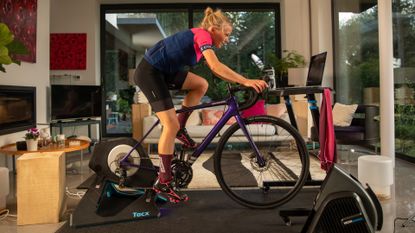

Best smart indoor trainers 2024
Entry-level
1. Best wheel-on
2. Best direct-drive
3. Best value accuracy
4. Cheaper alternative
5. Best value stability
6. Best value wheel-on
Premium
1. Best premium
2. Best for realism
3. Best for stability
4. Solid spec
Indoor trainers allow consistent, quantifiable riding whatever the weather and enable distraction-free training. Whether you are looking for a 'smart' or 'classic' style of trainer our guide will take you through the basics and cover the pros and cons of some of the best trainers on the market.
We have tested numerous trainers in Cycling Weekly, so you can be assured that the reviews below have come from extensive use and careful consideration and comparison.
Whilst some riders will opt for the simplicity of the old-style classic turbo trainer, most users will reap the benefit of a more modern smart trainer. These allow you to accurately measure your power output and can be paired with indoor cycling apps (compared: Zwift vs TrainerRoad vs The Sufferfest) for a more immersive and enjoyable experience that will encourage you to use the trainer more frequently.
If you have more space at home and a bigger budget then our guide to the best exercise and best smart bikes will be of interest, and it is also worth considering the best bike rollers too, as the ride experience is very different to smart trainers and smart bikes.
Our pick of the best smart turbo trainers
You can trust Cycling Weekly.
We've ridden and rated the top-selling smart trainers below, using Zwift as the virtual testing ground, taking into account their user-friendliness, functionality, features, and price for an overall score.
We recognise that the top smart turbo trainers are a big investment, so if you are on a tight budget you'll be pleased to hear it's still possible to get a cheap Zwift setup, especially if you opt for one of the best cheap trainers out there.
If you are new to indoor training, our beginner's guide to indoor cycling has everything you need to get you up and running.
Bikes attach to indoor trainers in two ways: with the 'wheel-on' type your bike is fixed to an A-shaped frame and its rear wheel drives a roller; with the 'direct drive' type you remove your bike's rear wheel and attach it directly via its dropouts to the turbo, which includes a cassette. Our wheel-on vs direct drive turbo trainers page weighs up the pros and cons of both.
The quick list
In a hurry? Here's a brief overview of the best smart trainers on this list, along with quick links which let you jump down the page directly to the product's review.
Entry-level
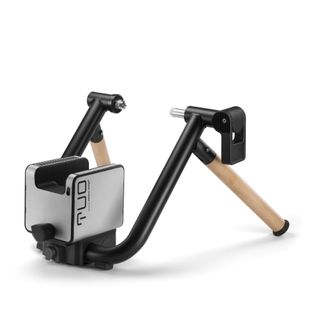
Best wheel-on overall
Striking aesthetics, good stability and reasonable accuracy make the Elite Tuo a great option for those on a budget. ERG mode is smooth and the unit remained stable under hard efforts.
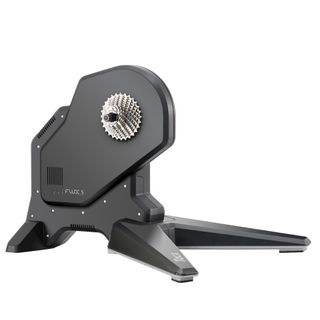
Best entry-level direct-drive overall
An excellent option if you have the space for a permanent set-up, the Flux S has an excellent ride feel, good stability and a very smooth ERG mode but it isn't very portable or packable. It also lacks ultimate accuracy and gradient replication for serious Zwift racers.
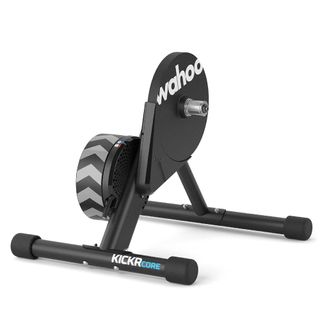
Best value entry-level direct-drive for accuracy
The extra cost of the Kickr gets you greater accuracy, impressive ride feel and a painful-sounding 16% gradient replication. It is a little lighter than the Flux, which helps if you have to move it around but is an awkward shape for storage.
Premium
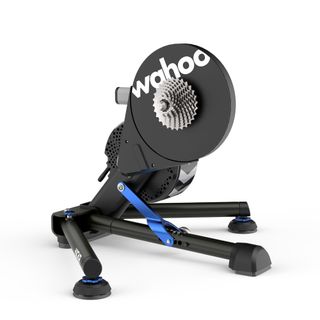
Best direct-drive for premium performance
Wahoo's Kickr V6 is a superb way to enjoy indoor training. ERG mode is smooth, ride feel is excellent and you won't hit the 2,200 watt buffer when it comes to power measurement. It can connect to Wahoo's stable of peripherals such as the Climb and Headwind whilst auto calibration and firmware updates keep it accurate.

Best direct-drive trainer for realism
The Tacx Neo 2's part y trick is its ability to simulate surfaces such as cobbles for extra interest and realism. It does this well, and the in-built flex also helps to more accurately reflect the feel of riding outdoors. ERG mode feels nicely fluid too, but it is a large unit when it comes to storage.
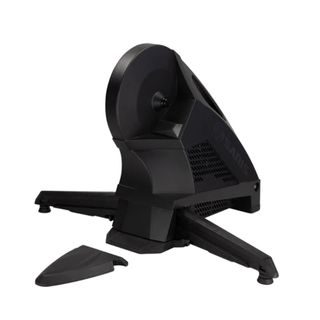
Best direct-drive trainer for stability in sprints
Offering little in the way of extra features, the H3 does provide an accurate and stable platform on which to train, with 2,000 watts of resistance and up to 20% gradients. This makes it perfect for hard interval sessions or sprint training and when you are finished, it packs away easily too.
Entry level smart indoor trainers
The best wheel-on smart trainer overall

The Elite Tuo is a smart-looking wheel-on trainer
Specifications
Reasons to buy
Reasons to avoid
Hands down one of the smartest looking indoor trainers available, the use of wood for the legs really sets the Elite Tuo apart visually from others on the market. This is a top-spec wheel-on smart trainer offering very good accuracy levels at a wide range of power outputs. We didn't have any issues with wheel slippage during our testing.
Set-up was easy with the myEtraining and Upgrado apps to update the firmware and also calibrate the trainer. ERG mode was also very responsive with programmes such as Zwift and Wahoo SYSTM.
We did have issues with power and cadence measurements when changing intensities more rapidly or doing sprint efforts, but as an introduction to using a smart trainer with very little faff, this is a very solid option. The low weight also makes it easy to move around or fold up for storage.
Read more: Elite Tuo smart trainer review
The best entry level direct-drive trainer overall
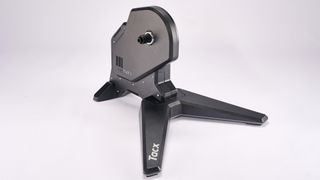
The Tacx Flux S performs above its middling price
2. Tacx Flux S
Our expert review:
Specifications
Reasons to buy
Reasons to avoid
First off, this is a really great turbo trainer. But that’s what makes this one a little frustrating, as it is just so close to being the obvious go-to for pretty much everyone. However, as it is, there will be some people for whom it’s not quite the right model – let’s go through the performance.
With the heaviest flywheel on test, the Flux S also comes in as the heaviest trainer overall. Couple that with its unique footprint and you’ve got an incredibly stable platform – I’d say even potentially a little more stable than its big brother, the Tacx Neo 2T, which I tested last year.
Likewise, the resistance and ride feel of this entry-level model is impressively close to that of Tacx’s flagship trainer. Changes in gradient were fast and smooth, whilst the resistance remained steady even when climbing at a low speed and low cadence – a challenging combination for a trainer.
The ERG mode coped well with even large differences in power. The resistance would ramp up quickly whilst also not crushing my cadence in the way the Zumo did. Another point of contrast is that when riding without the ERG mode on or not up any virtual gradients, I was able to push a comfortable cadence at 250w with plenty of sprockets to spare – no danger of spinning out.
In terms of the virtual ride feel and stability of the turbo, this was the best on test – and is better even than some turbos at a higher price point.
In having swept up on the fundamentals, it’s fair to ask whether it goes on to clear any of the higher bars – is there any point in buying a more expensive model? Sadly, yes there is. But only for people with quite specific use cases.
First, the accuracy. Rated at ±3% this is the same as the Zumo. But it’s worth pointing out this doesn’t meet the ±2% cut-off for the upper echelons of Zwift racing. For most people, this isn’t a consideration – the majority of Zwift users aren’t serious racers, and it’s only a very small subsection of them who would be racing in those categories, but it’s worth being aware of.
Similarly, for challenges such as a ‘virtual’ Everesting, the rules stipulate that the realism must be set to 100%. If you’re planning on using the Alpe du Zwift for your attempt, then you’re going to fall foul of ‘the rules’, as the maximum gradient on the Alpe is 14%.
Again both these points won’t matter to most people, and is part of the reason why this is the trainer that we would recommend overall. But just because this trainer is so good, it is worth being aware of exactly where the limitations are, so that there aren’t any surprises.
The other consideration is that this is not a trainer for moving about regularly or stowing away. The legs don’t fold and it is very heavy.
The best value entry level direct-drive trainer for accuracy
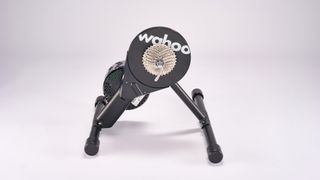
The Wahoo Kickr Core has much of the functionality of Wahoo's higher spec trainers
3. Wahoo Kickr Core
Our expert review:
Specifications
Reasons to buy
Reasons to avoid
The Wahoo Kickr Core and the Tacx Flux S line up for a particularly interesting contrast. It’s almost like a Venn diagram, but where the two circles have been pushed together so that it’s just a thin sliver on either side where there isn’t any overlap.
We’ll blast through the fundamentals pretty quickly again because, like the Tacx Flux S, the Wahoo Kickr Core executes these so well that it’s worth spending a bit more time on the hair-splitting points of differentiation.
Starting with the ride feel, I’d actually argue that the Core does better (in some aspects) than the flagship Kickr V5 I tested last year (although this model has now been surpassed by the Wahoo Kickr V6 and Wahoo Kickr Move).
How can this be? Well, my assumption is that it’s down to the weight of the flywheels. With the Kickr V5, it always felt like there was a great deal of inertia to spin up when accelerating – for me, it was a little less like riding out on the open road and a little more like that of a ‘spin bike’, with their huge fixed-gear flywheels.
True, the Tacx Neo 2T itself boasts an electromagnetic flywheel that can simulate a weight of up to 125kg, but it’s not simulating that all the time, and, in my opinion, it has more of a ‘road feel’ than that of a Kickr V5.
Coming back to the Kickr Core, with the flywheel being 5.4kg compared to the 7.3kg of the V5, the sensation of accelerating felt just a bit more natural for me. Although this should be heavily caveated with the point that if you’re a heavier rider, you might well find the opposite.
In terms of the response to sudden changes in gradient and interval sessions with large differentials of power in ERG mode, the resistance changed smoothly and quickly. It also didn’t have a particular propensity to ‘death spiral’ and force you into pushing an ever lower cadence – all very good and very similar to the Kickr V5.
As mentioned, the Kickr Core does manage to hit points that the Tacx Flux S has missed. With an accuracy of ±2%, this is one of the cheaper entry points to high-end indoor racing. Plus, with a maximum gradient of 16%, you’ll be able to cut your vEveresting teeth on the Alpe du Zwift and feel every ramp. It’s also an easier trainer to move around than the Flux S and takes up less space.
However, there are points which do let it down in comparison to the Flux S. First is the stability: these two-bar designs are much less stable than three-leg versions – and the Flux is particularly solid.
A cheaper alternative

The Jet Black trainer is easy to move around
4. Jet Black Volt 2
Our expert review:
Specifications
Reasons to buy
Reasons to avoid
Let’s get this out the way first: the Jet Black Volt 2 does look pretty similar to the Wahoo Kickr Core. Coming in at the same list price, simulating the same maximum gradient and delivering the same maximum resistance – you might start to wonder if anything is different at all.
On closer inspection, there are quite a few areas where the two trainers are distinct. The first clue is in the weight. At 15.4kg for the Jet Black Volt 2 compared to 18.0kg for the Wahoo Kickr Core, there’s obviously quite a chunk – to the tune of 2.6kg – that does vary between the trainers.
Part of that is down to the heft of the flywheel, coming in at 4.7kg for the Jet Black – the second lightest on test – compared to 5.4kg for the Wahoo Kickr Core. The housing of the flywheel also varies between them, with the Jet Black having a bit more of a plastic covering.
Rounding out the physical differences, the Volt 2’s legs are oval rather than circular and the front bar is fixed in place, whereas the Wahoo Kickr Core can be adjusted vertically.
The performance is quite different as well – although this doesn’t reflect so well on the Australian brand. Riding the Volt 2 on steep virtual climbs, the resistance felt distinctly choppy. It was like pushing through treacle between two and four o’clock on the pedal stroke, but past that, it would ease up significantly - almost slipping past - before ramping up again at two o’clock on the other crank arm.
To be fair, this wasn’t an issue when pushing higher power and cadence numbers (around 270w and 90 RPM), but the 180w and the 70 RPM that I was having these problems at aren’t ridiculously low. Even the most powerful riders ride around that level when recovering between intervals – and for others, this will be within their training zones.
I’m not entirely sure what the exact issue is here. You might think that it was the relatively light flywheel struggling with the steeper gradients, but the 7% inclines I first noticed the issue on were easily handled by the Elite Zumo – which has a lighter flywheel and a lower maximum gradient.
Although, with that said, the ERG mode wasn’t as aggressive as the Elite’s and it was possible to ride without any additional resistance from climbs or the ERG mode without spinning out – so the Volt 2 does have some positives over the Zumo.
Overall, the Tacx Flux S simply has a significantly better ride feel and, in those areas where the Flux S isn’t the test leader (i.e. accuracy and gradient simulation), the Volt 2 doesn’t ‘do the double’ either and so isn’t a compelling option.
Best value entry-level direct drive for stability
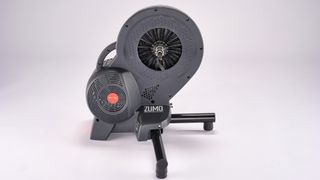
The Zumo was the least expensive in our four-way test
5. Elite Zumo
Our expert review:
Specifications
Reasons to buy
Reasons to avoid
The Elite Zumo’s spec sheet totally belies what a well rounded trainer this is. The cheapest trainer on test, it’s also the lightest and has the lightest flywheel, the claimed accuracy is joint worst at ±3% and the maximum resistance is the lowest at 1,350W. The slope simulation stands out as being second shallowest at 12%.
Most of those points are immaterial, though. The max gradient of 12% is still more than enough for all your low cadence/high power interval needs – it’s just that you’ll be pushing a slightly larger gear than with a Tacx Neo 2T or a Wahoo Kickr. Plus, if you haven’t fiddled with the default realism settings in Zwift at all, the maximum gradient of 22% will be reduced to 11% and within the trainer’s capabilities.
The maximum resistance of 1,350W is worth a little more of a consideration than that of the other turbos on test as it’s not a number that’s unfeasible for amateur riders to top. But as an amateur rider who’s never once topped 1,300w, I still haven’t been able to test its limits.
With that out of the way, let’s get onto the more important bits. First, the ride feel. Despite having the lightest flywheel on test, the sensation of riding was very smooth - much better than the Jet Black Volt 2. Riding around the Sand And Sequoias map on Zwift, it responded to the gradient changes quickly and proportionally with barely any lag.
So far so good, but the flipside to this is that when riding in ERG mode and doing a session such as 20/40s or 10x1min – anything where there’s a big power differential – you can quite easily end up in something of a ‘death spiral’ of ever-increasing resistance as you struggle to spin your legs up to speed.
This is true of all trainers to some extent, it’s generally a good idea to spin up your cadence just before entering those intervals to give yourself a bit of a buffer. But this was a particular issue for the Zumo – and was also a problem for the higher-end Direto that we tested last year, so it seems that this is a more general problem for Elite.
And speaking of general problems for Elite, when doing turbo sessions without ERG mode, I found it was quite easy to end up running out of gears and spinning out. Even with a 50x11t combination – actual road, not gravel – I had to pedal uncomfortably fast to hold 250w.
This isn’t an issue if you only freeride in events and the like with the realism on, and it’s not an issue if you only ride in ERG mode (plenty of resistance can be provided there). But this is an issue for those who like the mental challenge of consciously holding a set wattage. And this is also an issue that Elite turbos have had problems with in the past – not the aforementioned Direto, which was fine, but the lower-end wheel-on Tuo.
In all, the Zumo is super portable thanks to its carry handle, foldable legs and general lightweight build. At the same time, it’s very stable thanks to its wide footprint and the resistance is very nicely controlled and feels very smooth despite the smaller flywheel.
Best value wheel-on smart trainer
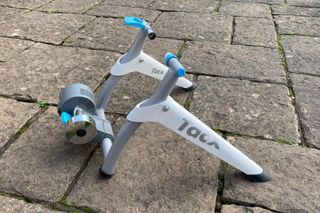
The Tacx Flow is a sturdy budget trainer
6. Tacx Flow smart turbo trainer
Specifications
Reasons to buy
Reasons to avoid
The Flow Smart from Tacx strikes a great balance between connectivity and budget, allowing you to link it up to platforms like Zwift, TrainerRoad etc and enjoy the auto-changing resistance without the big price tag.
The maximum power is 800 watts, and the maximum incline is 6% which will be enough for many riders, although some stronger cyclists may well find they max it out during a full pelt sprint, or find it slightly wanting on a climb as happened to us.
The Flow Smart uses Bluetooth Smart Open and ANT+ FE-C to transmit data, has a magnetic resistance unit and provides cadence, power and speed outputs.
As well as being very competitively priced, the Tacx Flow Smart is very portable. The compact flywheel, which weighs 1.6kg, keeps the overall weight down to 9.4kg, making it very easy to fold away or transport in the back of the car for a pre-race warmup to be used as a standalone turbo trainer.
Read more: Tacx Flow Smart Trainer full review
High-end smart indoor trainers
The best direct-drive trainer for premium performance
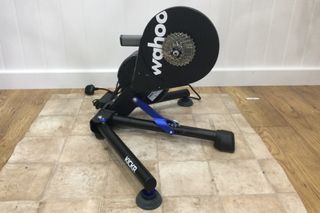
WiFi connectivity makes for easy set-up of the Kickr V6
Specifications
Reasons to buy
Reasons to avoid
The Wahoo Kickr V6 has been one of the top direct-drive trainers ever since the original model was launched 10 years ago. The recent updates have added WiFi connectivity and a smoothed ERG mode which improve the Kickr that much further, albeit incrementally rather than fundamentally.
Should your legs be able to get anywhere close to it, the maximum power of the Kickr V6 is 2,200W, it offers a simulated gradient of -10% to +20% and power accuracy of +/-1%. All impressive numbers.
Our tester found that the ride feel is impressive too; smooth and responsive with a well-tuned ERG function that does such a good job at matching your torque and cadence to your power targets that you wouldn't know it was happening if it wasn't for the numbers in front of you. The new ERG Easy Ramp gives you a bit of leeway to get going again should you dare slack off your effort for a few seconds.
As well as automatic firmware updates, integrated WiFi allows for easier and more stable connection to your devices which will help you and your system keep up with the capabilities of the training apps and the ever-more immersive virtual riding experience.
Read more: Wahoo Kickr V6 smart turbo trainer full review
The best direct-drive trainer for realism
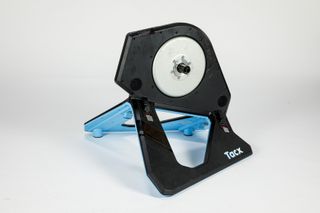
The Tacx Neo 2 can simulate riding on gravel and cobbles
Specifications
Reasons to buy
Reasons to avoid
Being the most expensive trainer on test, naturally, it’s also the one which offers the most in terms of added features. Equally, in charging such a premium, Tacx has set a very high bar for itself that it now has to clear.
Just relating to its packability, the Neo 2T isn’t as user-friendly as the other turbo trainers. Folding the legs up – rather than just sliding them together – presents a bit more of a faff, while the lack of a single carry handle means that the turbo requires two hands to port it around.
However, when set up, the Neo 2T does deliver a pretty unique riding experience – for one thing, it’s able to simulate the sensation of riding over cobbles, wooden boards and other surfaces quite realistically by just modulating the resistance through the pedals. You might have thought some form of jolting or vibration would be necessary but, from my experience, surprisingly it is not.
There’s also a large degree of inbuilt flex to better simulate the natural sway of riding outdoors. Wahoo has attempted something similar with its new feet for the Kickr, but the result is much less noticeable.
Finally, the Neo 2T’s electromagnetic flywheel really nails the feeling of sprinting out on the road. You get that feeling of massive torque as you first stamp on the pedals and get the gear turning, with that resistance quickly easing off as you spin up to speed – requiring fast, repeated shifts down the cassette to match that speed.
It’s all very impressive, but for sprints and hard efforts on the turbo, realism can be more of a hindrance than a help. That inbuilt flex makes the turbo feel a bit of a noodley and hampered my top-end power output. Also, the lifelike mimicking of the resistance when sprinting means that you’re forced into quickly shifting through the gears, increasing the chances of a miss-shift as well as cognitive load.
Of course, perfecting your gear shifts while sprinting is a skill that’s necessary to learn, but that’s best done when out on the road, actually sprinting, and honing your handling and body position at the same time. On the turbo, it’s generally nicer to just focus on the effort.
The ERG mode felt very fluid and the resistance changes felt nicely natural – even for large swings, as in a 30s on 30s easy session. A bonus is that the trainer doesn’t need to be calibrated, so you can just hop straight on and go, which is always nice. Also, the watts drop to zero pretty quickly, so it’s good for that aspect of Zwift racing, if not so good for sprinting.
In all, the lack of a good carry handle, the instability and resistance curve for sprinting and the high price all count against the Tacx Neo 2T. It ranks very well for realism, with that sway, resistance curve and surface simulation, but the lack of matching riser unit availability does make it difficult to fully recommend as the ‘ultimate realism experience.’
Read more: Tacx Neo 2T smart turbo trainer full review
The best direct-drive trainer for stability in sprints

The Saris H3 is very stable under out of saddle efforts
Specifications
Reasons to buy
Reasons to avoid
The Saris H3 is the most pared back of all the trainers on test. In terms of extras, there’s no option for a riser unit to lift the front wheel, and there’s no inbuilt rocking function to simulate the sway of a bike or any other novelties to add to the indoor riding experience.
Instead, the H3 is all about delivering a solid platform for hard efforts – which could very well be all you're after. There's little point in paying extra for features you're not going to benefit from and the H3 does undercut the Wahoo Kickr and Tacx Neo 2T on price.
Although not the heaviest, the Saris H3 is the most solid direct-drive turbo I’ve come across for sprints. That’s not to say it stays perfectly in place – not even the Tacx Neo Bike Smart does – but it represents a significant step up from other trainers. Like the Elite Direto XR-T, the resistance curve when sprinting also has a good feel to it, not requiring an excessive number of shifts as you wind up the watts.
Packing the turbo away, the legs fold elegantly into the body, leaving a width comparable to the Elite Direto XR-T, but having a significantly shorter footprint and standing a little lower. The carry handle is in essentially the same position as the Direto XR-T, which means carrying it around is equally more cumbersome than the Kickr.
The sensation of the ERG mode is kind of middle of the road. I didn’t have any issues with death spirals of ever-increasing resistance and the changes in resistance didn’t catch me by surprise. But it did lack a bit of a feeling of souplesse that the Tacx Neo 2T and Wahoo Kickr have been able to capture.
Onto the negatives, the fact that you have to manually perform calibration spindowns to keep the power numbers on track, adds a bit of extra faff. Also, the body of the turbo doesn’t play nicely with thru-axle handles or bulky multi-tools – you have to use the long end of an Allen key to screw in the axle most of the way and finish the last bit in 3/4 turns.
Finally, although the H3 drops to zero watts impressively quickly when you stop pedalling – about the same amount of time as the Tacx – it consistently gives a 10-watt spike just afterwards, which will pull your avatar out of the ‘supertuck’ position for another couple of seconds.
Overall, the Saris H3 is a solid option that undercuts both the Wahoo Kickr and Tacx Neo 2T.
Read more: Saris H3 smart turbo trainer full review
Solid spec and often discounted
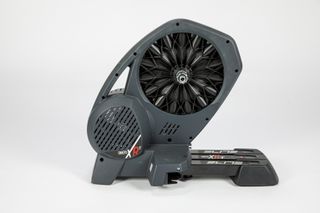
You can often find the Elite Direto at a discount
Specifications
Reasons to buy
Reasons to avoid
The Direto XR-T comes shipped in its packed-away state, so setting it up straight out of the box is much the same as setting it up for a turbo session. Simply spread out the legs and hand-tighten the screws to lock them in place – it takes about 20 seconds at most.
With a relatively narrow profile once the legs are folded away, finding a home for it between sessions isn’t much of a challenge, although being a little taller and longer than the other turbos on test does make it a touch more imposing. The placement of the carry handle isn’t a natural feel for its center of gravity, however, so lifting the turbo does feel more awkward than its (relatively) low weight would suggest.
Putting in some sprints and harder efforts, the lighter weight of the Direto XR-T does make itself known, shifting and sliding around. But with that said, the wide platform means that it never felt unstable at all, even if you can end up making it a reasonable distance across the room.
In terms of the turbo’s resistance when winding up a sprint, there’s a nice, even sensation to it, reducing the number of gear shifts you need to make compared to other trainers – such as the Tacx Neo 2T in particular. The main benefit is to save wear on your drivetrain and allow you to focus on the effort, more than coordinating shifts.
Of all the trainers on test, the Direto XR-T’s ERG mode, unfortunately, really stands out. When an ERG mode is working as it should, the trainer will adjust its resistance to keep you held at a set wattage – pedal faster and it will reduce the resistance; pedal slower and the resistance will increase. It’s a good system for forcing an effort when you’re lacking the mental will to ride the set pace.
With the Direto XR-T, if you drop your cadence slightly, it will immediately ramp up the resistance – in turn, often causing another drop in cadence and thus precipitating something of a death spiral of ever-increasing resistance.
Similarly, when doing a session such as 30s on / 30s easy, you’ll want to really spin up your legs before the ‘on’ interval starts, otherwise you’ll feel like you’ve cycled straight into a brick wall.
On the other hand, this super fast ramping up of the resistance is great for rolling courses on Zwift, with sudden and repeated gradient changes. Combined with the option of pairing this turbo with a riser unit (not reviewed), Elite stands to offer a pretty immersive virtual riding experience.
However, one important feature of Zwift racing is ‘super tucking’ on descents – stop pedalling and your avatar will assume a more aero position and you can catch your breath for a second. Once you stop pedalling with the Direto XR-T, though, it takes well over 10 seconds for it to actually register that you’ve stopped pedalling, essentially ruling out that technique.
If you aren’t a heavy user of ERG mode or an avid Zwift racer, the overall performance is quite good and the trainer can often be found at a hefty discount. But compared to the other trainers on test, the performance is lacking and the full RRP isn’t low enough to make the sacrifices worthwhile.
Read more: Elite Direto XR-T smart trainer full review
Buyer's guide to smart indoor trainers
What are the different types of turbo trainer?
Magnetic turbo trainers
The most basic turbo trainers use magnetic resistance to imitate the feel of the road and are generally the cheapest due to their simplicity. There are, however, few smart versions available. Usually supplied with a manual resistance changer, their smart capabilities aren't as varied as others and can't be programmed to replicate a certain gradient or power resistance.
Wheel-on trainers of any type tend to eat through tire rubber quickly. You can buy a trainer tire for your rear wheel which is made of more resistant rubber, but this then means that you need to have a second wheel available or make a tire swap when you want to venture out onto the road.
Fluid trainers
A step up from the magnetic trainers, fluid models are much quieter and have a progressive resistance curve, meaning the faster you get, the harder it is to ride. These are where the majority of affordable smart trainers will be based as there is more room to integrate smart capabilities into fluid trainers, have a good ride and still hit a lower price point.
Direct drive trainers
Direct-drive turbo trainers take the bicycle's rear wheel out of the equation by attaching directly to the drivetrain, hence the name. As the drivetrain is directly linked to the turbo trainer, taking its power measurements from the cassette rather than the tire, direct drive is the most accurate type.
These turbo trainers are usually electronic and have to be plugged into the wall so that their motors can be powered and resistance can be automatically altered when an app is controlling it.
By forgoing the need for the rear wheel, you don't have to buy new tires regularly, as you would with any of the wheel-on trainers.
What are the alternatives to smart turbo trainers?
Along with exercise bikes and smart bikes, there are also some smart interactive rollers available on the market.
Rollers are the perfect training tool for those who are a little more confident on their bike or riders looking to improve the efficiency of their pedal stroke.
Because you're actually riding your bike and moving around, rollers don't suffer the same issues with on-bike comfort as turbo trainers do, and the floating system included in most rollers absorbs abrupt movement that would otherwise send you flying over the edge.
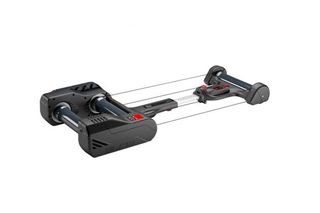
Rollers are an alternative to a turbo trainer for more experienced riders
The other benefit of rollers is the ease of bike mounting - just put your outdoor bike on and start riding. The Elite Nero Interactive, pictured above, is one of our favourites, providing up to 830 watts max resistance and a 7% grade. You can read about rollers and see more on our best rollers for indoor cycling page.
Why choose a smart turbo trainer?
For many people a standard magnetic wheel-on turbo trainer may do the trick, but going for a smart trainer will ensure a much more engaging and measurable training session.
Firstly, their smart functions mean that they can connect to a whole host of indoor training apps like Zwift, TrainerRoad and Wahoo RGT. Apps like Zwift interact with your turbo trainer to measure your effort and apply it to a virtual avatar riding in a simulated world against other people over the internet - much better than staring at a garage wall.
Other apps like Rouvy and Wahoo RGT enable you to recreate any real Strava ride you've done. For example, if you've found the perfect training route but can't get out of the house, the trainer can realistically mimic every dip and climb. You can even replicate a ride in the Alps in your living room!
The other main benefit is that you can complete your session without being interrupted by traffic, stoplights, hills or corners. If you've planned anything from power-based steady-state intervals to sprint reps you ideally need a consistency of conditions that you can't always find on the open road.

Hook up a smart indoor trainer to an indoor cycling app for a more immersive experience
If you are concerned about motivation, here are eight ways to make your turbo training sessions more enjoyable to keep you consistent with your indoor training.
Smart trainers also offer the chance to record more data than you may have thought even existed, on either one of the best bike computers or one of the best smartwatches for cycling. If you like numbers this is the way to go!
How we test
All the smart trainers in this buyer's guide have been used and abused by Cycling Weekly staff over many hours and countless virtual kilometres. Ease of setup, app connectivity and portability have all been considered alongside the trainer's statistics and features. Maximum resistance, gradient simulation and accuracy are all important considerations, but perhaps most important of all is the rather ephemeral concept of 'ride feel' - that is what pedaling feels like on the trainer at both low and high cadence or during minimal and maximal efforts. This, perhaps more than anything else, dictates how enjoyable a trainer is to use.
Get The Leadout Newsletter
The latest race content, interviews, features, reviews and expert buying guides, direct to your inbox!

After winning the 2019 National Single-Speed Cross-Country Mountain Biking Championships and claiming the plushie unicorn (true story), Stefan swapped the flat-bars for drop-bars and has never looked back.
Since then, he’s earnt his 2ⁿᵈ cat racing licence in his first season racing as a third, completed the South Downs Double in under 20 hours and Everested in under 12.
But his favourite rides are multiday bikepacking trips, with all the huge amount of cycling tech and long days spent exploring new roads and trails - as well as histories and cultures. Most recently, he’s spent two weeks riding from Budapest into the mountains of Slovakia.
Height: 177cm
Weight: 67–69kg
-
 Nightmares, niceties and gnarl: 10 years of the Transcontinental Race
Nightmares, niceties and gnarl: 10 years of the Transcontinental RaceThe ultra-distance benchmark that pits riders against a 4,000km self-supported Europe-wide trek reaches double figures
By James Shrubsall Published
-
 Why the best commute will always be aboard my old steel fixie
Why the best commute will always be aboard my old steel fixieCharming, simple, and always a great workout, this is the perfect town bike
By Joe Baker Published
-
 Best exercise bikes and smart indoor bikes for home workouts 2024
Best exercise bikes and smart indoor bikes for home workouts 2024Looking to get a pedal fix indoors? Here's our pick of the best exercise bikes and best smart bikes to keep you riding at home
By Hannah Bussey Last updated
-
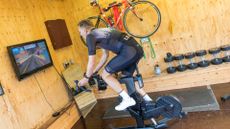 Best indoor cycling clothing 2024 to keep you going nowhere in comfort
Best indoor cycling clothing 2024 to keep you going nowhere in comfortThe best indoor cycling clothing can help prevent saddle sores and keep you cool indoors
By Michelle Arthurs-Brennan Last updated
-
 Best Peloton alternatives for indoor cycling
Best Peloton alternatives for indoor cyclingAfter an alternative to a Pelton bike? Here's our pick of the best on offer right now.
By Hannah Bussey Last updated
-
 Best headphones for cycling 2024 indoors and outdoor options
Best headphones for cycling 2024 indoors and outdoor optionsThe best headphones for cycling let you safely listen to music, podcasts, or even talk online e-racing tactics
By Hannah Bussey Last updated